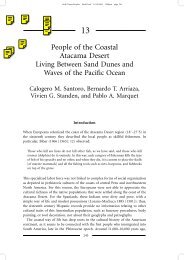Late Quaternary History of the Atacama Desert.
Late Quaternary History of the Atacama Desert.
Late Quaternary History of the Atacama Desert.
You also want an ePaper? Increase the reach of your titles
YUMPU automatically turns print PDFs into web optimized ePapers that Google loves.
82 part one environmental historyongoing midden research at Río Salado in <strong>the</strong> Calama Basin, this wet phasemay have begun as early as 17,400 cal. BP, coinciding closely with globallywarmer temperatures and <strong>the</strong> onset <strong>of</strong> deglaciation at higher latitudes. Fur<strong>the</strong>rresearch, however, in <strong>the</strong> central <strong>Atacama</strong> will seek to establish <strong>the</strong> full extent<strong>of</strong> <strong>the</strong> mid-Holocene wet phase, dated approximately 7000 to 3000 cal. BP. Ourevidence is at odds with <strong>the</strong> notion <strong>of</strong> a silencio archaeológico, a conspicuous,temporal gap in <strong>the</strong> archeological record attributed to greater mid-Holocenearidity (Grosjean et al. 2001; Núñez et al. 2002).The sou<strong>the</strong>rn <strong>Atacama</strong> (24–27°S)With very little rainfall ei<strong>the</strong>r from tropical or extratropical sources, this sectoris undisputedly <strong>the</strong> driest portion <strong>of</strong> <strong>the</strong> <strong>Atacama</strong> <strong>Desert</strong>. Inland penetration<strong>of</strong> absolute desert may reach 4000 metres in altitude along <strong>the</strong> western slopes<strong>of</strong> <strong>the</strong> Cordillera Domeyko, with peaks that here rise to over 5000 metres inaltitude. Many closed basin salars (salt pans and playas) dot <strong>the</strong> high elevationintermontane basins found between <strong>the</strong> Domeyko and Andes cordilleras.Among <strong>the</strong> most prominent are Salar de Punta Negra, Salar de Pedernales andSalar de Maricunga. The sharp sou<strong>the</strong>rn boundary <strong>of</strong> <strong>the</strong> <strong>Atacama</strong> is delimitedby increased penetration <strong>of</strong> <strong>the</strong> westerlies during winter.Quebrada Chaco is a steep, walled canyon occupied by a dry streambed.The stream course begins at approximately 4000 metres in <strong>the</strong> CordilleraDomeyko, starts to form a defined canyon at 3700 metres, crosses an activespring just downstream <strong>of</strong> a 30-metre nickpoint and dry waterfall at 3400metres, and eventually shallows into a wide floodplain at 1500 metres. Asidefrom local vegetation around a few springs, <strong>the</strong>re are only a few shrubs andannual herbs below 3500 metres, mostly along dry washes. Some <strong>of</strong> <strong>the</strong> lowelevation plants share a close affinity with those found along <strong>the</strong> coast in <strong>the</strong>specialised lomas fog communities, endemic relicts that probably formedduring <strong>the</strong> Tertiary (for example Malesherbia and Nolana). These constitute<strong>the</strong> desert perennials in figures 6.1f–h. O<strong>the</strong>r species are <strong>of</strong> Andean affinities(<strong>the</strong> ‘Andean’ perennials), which become more abundant above 3500 metres,although mostly confined to <strong>the</strong> canyon itself. Starting at 3900 metres,
















